|
Exploring Ancient Mongolia from Your Armchair
Ciitizen scientists explore homeland of Genghis Khan from afar as part of new National Geographic-supported expedition.
Tiffany Fox | Nov. 15, 2010
"Citizen archaeologists" are helping researchers find Bronze Age burial sites and other Mongolian antiquities as part of a new National Geographic-supported expedition that kicked off this summer. The groundbreaking "Field Expedition: Mongolia - Valley of the Khans Project" invites Web users around the world to join a field expedition online in real time as "citizen scientists" from the comfort of their homes.The field expedition is headed by National Geographic Emerging Explorer Albert Yu-Min Lin of UC San Diego.
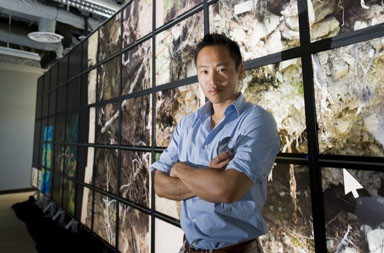
UC San Diego researcher Albert Yu-Min Lin has partnered with the National Geographic Society in a project to use the power of human computation to analyze more than 6,000 square kilometers of Mongolian wilderness in a search for archaeological sites.
The field expedition, headed by National Geographic Emerging Explorer Albert Yu-Min Lin of the University of California, San Diego, in collaboration with professors Shagdaryn Bira and Tsogt-Ochiryn Ishdorj of the International Association for Mongol Studies, and National Geographic Archaeology Fellow Fredrik Hiebert, is using modern, noninvasive tools to explore and map parts of Mongolia including the “forbidden precinct” — the homeland of Genghis Khan, which has gone unexplored for 800 years. The project is searching for archaeological sites that shed light on the country’s rich cultural history and heritage while maintaining respect for local customs and beliefs.
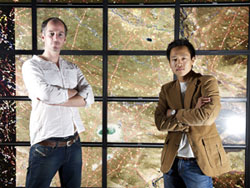
Calit2 researcher Luke Barrington (pictured at left) and Lin enlisted more than 6,000 online explorers to look for clues in 84,000 individual digital images culled from GeoEye satellite data.
In a first for National Geographic Digital Media, “Field Expedition: Mongolia” features an online component that encourages active participation by the public — known as human computation, or “crowdsourcing” — through a customized interactive Web portal. Using map-accurate, high-resolution satellite imagery made available by the GeoEye Foundation, citizen scientists analyzed real-time data, maps and other information direct from the field to mark anomalies that might represent archaeological ruins. The field team then used information the taggers collected to “ground-truth” the tagged sites, employing ground-penetrating radar, unmanned aerial vehicles, remote sensors and on-site digital archaeology. Human computation is an ongoing research focus at UCSD’s California Institute for Telecommunications and Information Technology (Calit2).
“The power of crowdsourcing is utilizing the very human traits that we take for granted, such as the fact that we can identify something that is natural versus something that is man-made,” explains Lin, who is affiliated with Calit2’s Center of Interdisciplinary Science for Art, Architecture and Archaeology (CISA3). “It’s hard to write a computer program that will tell you the same thing.”

A team of computer, electrical and cognitive scientists at UCSD's Calit2 wrote the crowdsourcing algorithm that allowed "Field Expedition: Mongolia" to capture user tags and the back-end scripts that cut GeoEye's satellite images into manageable sizes for users.
Still ongoing, “Field Expedition: Mongolia” launched June 9, 2010, and has drawn more than 6,000 taggers who have pinpointed more than a million specific areas of interest. One of the most active taggers has been Allison Shefcyk, a 24-year-old from West Hartford, Conn., who has yearned to be an archaeologist since childhood. Shefcyk said she knew little about Mongolia before embarking on the search. “When I first heard about the expedition, I decided I had to learn more about Mongolia in order to get a better idea of what I was looking at,” she said. “That meant looking carefully at the blog (on the National Geographic website), going to the library, etc. I quickly became captivated by this unique and beautiful country.” Shefcyk has tagged about 50,000 sites.
Satellite imagery taggers identified a wide range of interest points on the ground in the vast open spaces of Mongolia. The team rushed to one promising site only to find it was actually a herd of sheep. However, other leads were more fruitful. Some were found to be “khirigsurs,” large tombs encircled by rings of rocks that date to the Bronze Age, more than 3,000 years old. Some sites were found to be looted, perhaps recently. Team archaeologists are analyzing the data collected.
Archaeology in Mongolia is complicated by the nomadic nature of its historic inhabitants and the size of the country — Mongolia is slightly smaller than the state of Alaska. “Perhaps the main goal of the Valley of the Khans project is to help give these people a voice and to protect this area that abounds with ancient history,” the expedition blog states. “By learning about the history of this region, we can prove its significance to Mongolian life and a heritage that shaped the world.”
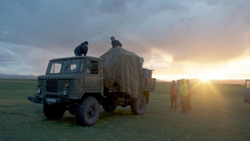
Lin and 10 other explorers spent the summer in northern Mongolia undergoing a process of "ground-truthing," or using the crowd-sourced tags, GPS data and time-stamped, geo-referenced photographs to pinpoint three areas of interest.
The hope is that many of those landmarks will eventually be protected as UNESCO World Heritage Sites. “It’s almost like the crowd is guiding us,” Lin says. “We’re entering a new information processing era where the networks being created through the Internet are allowing us to approach collaboration on a whole new scale.”
High-resolution satellite imagery for “Field Expedition: Mongolia” is provided by the GeoEye Foundation, a nonprofit organization established in 2007 to help train others to map, monitor and measure the Earth. The Foundation’s focus is to foster the growth of the next generation of geospatial technology professionals; provide satellite imagery to students and faculty to advance research in geographic information systems and technology as well as environmental studies; and assist nongovernmental organizations in humanitarian support missions. The Virginia-based GeoEye Foundation donated all of the satellite imagery and arranged for additional satellite “fly-overs” when new images over specific areas were needed by the researchers.
A team of computer, electrical and cognitive scientists at UCSD’s Calit2 wrote the crowdsourcing algorithm that allowed “Field Expedition: Mongolia” to capture user tags and the back-end scripts that cut GeoEye’s satellite images into manageable sizes for users. UCSD scientists wrote the program that provides taggers with feedback on how well they tagged an image, offering advice and showing where others tagged items. UCSD researchers also provided blog updates and reports from the field. These mechanisms combined to allow thousands of online participants to virtually join the expedition team in Mongolia from their homes. Human intuition data points generated by “Field Expedition: Mongolia” taggers help back-end computers learn to accurately identify ancient structures and supplement existing UCSD computer object-recognition algorithms.
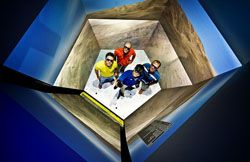
Calit2's StarCAVE's immersive virtual reality environment makes it possible to view inaccessible regions of Mongolia in high-resolution 3D.
The enthusiasm for learning and exploration evidenced during the “Field Expedition: Mongolia” holds great promise for future explorations and research projects in a variety of fields, says Calit2 research scientist Lin. “We’re still very far away from the day when we have made human observation obsolete,” he says. “Lots of problems in science are computationally exhaustive and most are still beyond the capacity of computing systems. Now you can imagine the next level: Taking that collective thinking and having it guide itself toward the evolution of its own platform, where the crowd determines where it wants to go and what kinds of problems it wants to solve.”
Digitaria, a leading digital marketing and technology firm, designed the look and feel of the “Field Expedition: Mongolia” website, and developed the flash-driven front-end interface that displays the satellite images and tools used to tag the features, including roads, rivers and ancient structures. The interface was created to meet the design criteria of UCSD scientists, whose goal is developing intuitive mechanisms and motivational elements that allow the crowd to be harnessed as a data-gathering machine. This process, human computation, enables large numbers of people who lack relevant training to help the scientists accurately analyze huge volumes of data. Digitaria also built out the registration process and blog template.
About National Geographic Digital Media
National Geographic Digital Media (NGDM) is the multimedia division of National Geographic Ventures, the wholly owned, taxable subsidiary of the National Geographic Society, one of the world’s largest educational and scientific nonprofit organizations, working to inspire people to care about the planet.
Holding many top industry awards, NGDM publishes www.nationalgeographic.com; produces short-form video for broadband markets; manages marketing and content partnerships across broadband, mobile, gaming and other consumer digital platforms; and provides video and film footage to commercial, theatrical, educational and other digital footage markets.
An (Electrical) Engineer for Exploration
Luke Barrington is a Ph.D. candidate in UC San Diego’s Electrical and Computer Engineering department – not the typical background of someone who might find himself trekking through Mongolia as part of a National Geographic archaeological expedition (see news release at left). But there he was this summer – after developing the core functionality of the expedition's online, human-computation website that gave the public at large a chance to “tag” potential historic sites on high-resolution maps of the area.
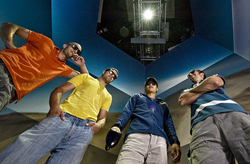
With the StarCAVE, Lin and his team can analyze the thousands of 'anomolies' that were tagged by citizen scientists and narrow down areas of historical significance.
"We were trying to spot anomalies, but until we had people examine the data, we didn’t know what those anomalies might look like,” recalls Barrington, who works in the Calit2-based Computer Audition Lab. “Would they be circular, square, man-made, natural? We knew we needed subjective, human intuition to crack the problem, especially since there was so much data and at such a high resolution that every pixel represented one meter."
As visitors to the National Geographic website used the UCSD-designed tagging system, the ground expedition in Mongolia was able to download the data and act on it in near real time.
"Every morning we’d use the satellite modem in our ger [portable dwelling] to download new data from the virtual explorers,” says Barrington, who is a key participant in the new UCSD-National Geographic Engineers for Exploration program. "We'd look for clusters of tags around interesting locations, load the coordinates on our GPS devices and then jump on our horses to go check them out."
Later, back in the lab, the scientists analyzed the gathered data using modern digital tools, including digital image processing and Calit2’s HIPerSpace wall, a massive video wall where the search lights up in real time.

Lin and his team also make use of the Calit2 HIPerSpace display to view large amounts of geographical data in their quest to pinpoint Bronze Age burial sites and other Mongolian antiquities.
For Barrington, the experiment in human computation was a resounding success. "A lot of people wrote to thank us, saying they had always wanted to be an archaeologist and this gave them an opportunity to be one," says Barrington. “Other people told us they got involved because they wanted know more about Mongolia, and our project motivated them to check out books from the library. Some people even sent us satellite images they had stitched together using Photoshop."
Adds Barrington: "There are millions of people every day on the Web. If we can get one percent of the people playing ‘Farmville’ every day to figure out instead how to map the structure of the human brain or the coral reefs of Australia, then that’s a worthy goal."
|